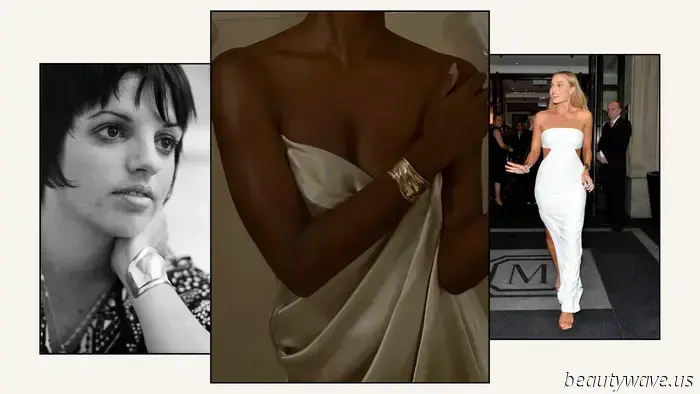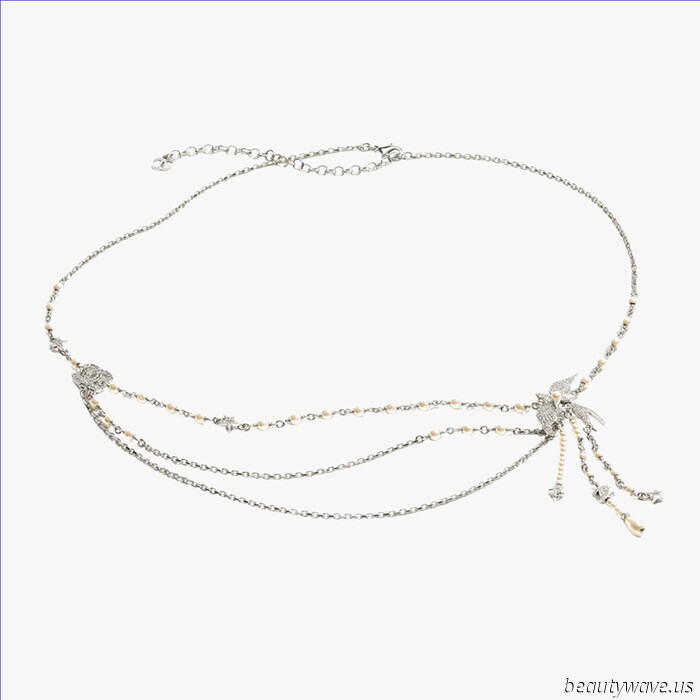
For the past 50 years, the elite in fashion have discreetly adorned themselves with this exclusive piece of jewelry.
For some, the wrist is merely a spot for jewelry, but for avant-garde jewelry designer Elsa Peretti, it was an integral canvas for her artistry. In 1970, this perspective led her to create the iconic Tiffany & Co. Bone Cuff. The sculptural design of the Bone Cuff features soft curves that conform to the body's shape, elegantly wrapping around the arm and extending at the small, pea-like portion of the wrist known medically as the pisiform. Now, more than fifty years later, the Bone Cuff stands as one of the most notable and influential designs of the 20th century, worn by a diverse range of personalities from Margot Robbie and Jasmine Tookes to Samantha Jones and Wonder Woman, each embracing the New York brand's esteemed emblem. But how did a piece inspired by a childhood visit to an Italian crypt evolve into a symbol of refined taste, finding its way to fashionable individuals worldwide? As we trace its legacy—from its creation to its association with Manhattan, gracing Met Gala events and Studio 54's dance floors—join me in exploring the history and significance of the Tiffany & Co. Bone Cuff.
Shop the Tiffany & Co. Bone Cuff:
Tiffany & Co.
Elsa Peretti® Medium Bone Cuff
Equally striking alone or when worn on both wrists.
What Is the Tiffany & Co. Bone Cuff? The Tiffany & Co. Bone Cuff is a metallic bracelet crafted to match the body's natural curves, endowing the piece with a sensual appeal due to its inherent shapes and graceful flow. Initially envisioned as a gold bangle that tightly embraced the forearm, it offered a commanding look. Peretti originally intended for wearers to adorn both wrists with the Bone Cuff, styling them as a cohesive pair.
Today, the Bone Cuff comes in various iterations. In 2024, Tiffany & Co. launched new designs to commemorate the 50th anniversary of Elsa Peretti's collaboration with the brand, including limited editions set with pavé diamonds. There are three primary sizes of the Bone Cuff: small, medium, and large. The small version is 43 millimeters wide with an asymmetrical shape, while the medium version is 61 millimeters wide with a more pronounced ridge and curvature. The large version, recognized by its 95-millimeter width, features a distinct split in the middle.
To Chelsea Fairless, a Los Angeles-based tastemaker, author, and co-host of the notable podcast Every Outfit, the Bone Cuff represents more than just jewelry—it's a “classic design object, akin to an Eames chair. It’s completely timeless yet immensely emblematic of the glamour of the ‘70s, Halston, Studio 54, and everything associated with it."
How Did Elsa Peretti Design the Tiffany & Co. Bone Cuff? Peretti's inspiration reportedly came from a rather grim source: a Capuchin crypt in Rome that she visited during childhood. The chilling memory of being close to the skeletal remains of thousands of deceased monks and friars stuck with her, a sentiment she once humorously expressed, saying, “things that are forbidden remain with you forever.” The Catalan architect Antoni Gaudí, known for his significant contributions to Barcelona's Art Nouveau movement, has also been cited as an influence. These inspirations reflect Peretti’s aim to elevate the ordinary and reveal her identity as an artist. For context, Peretti was born in Florence, later moving to Spain and ultimately New York, where she worked as a model before pursuing jewelry design.
This transient nature is what characterizes the Bone Cuff, drawing bohemian and free-spirited icons of the time to the piece. Fairless recalls her early memories of the cuff being tied to Liza Minnelli, her childhood idol. "For me, Liza is the ultimate style icon, and the cuffs are essential to her aesthetic," she states, noting Minnelli's appearances with the cuff at Studio 54 and in many iconic portraits.
On the design, Minnelli noted in Vanity Fair, “Elsa highlighted all these elements—the Bone [bracelet] stands out most to me. It felt so sensual and sexy. I simply adored it. It was unlike anything I had encountered before, and I had seen a lot. Since then, Peretti's jewelry has been my go-to.”
Why Is the Tiffany & Co. Bone Cuff So Iconic? Upon its release, the Bone Cuff received wide acclaim, appearing on the wrists of celebrities like Grace Jones and Sophia Loren. It was distinctive in form, unpretentious yet alluring, and made entirely of sterling silver, a material that was somewhat overlooked at the time. Constructed from solid pieces, the cuff was painstakingly handcrafted when it first launched.
Like many timeless jewelry pieces, its lasting appeal stems from its classic design. It does not conform to fleeting trends or niche aesthetics, maintaining relevance in the fashion world for over fifty


















Other articles
 9 Styles That Show Almond Milk Nails Are the Most Stylish Summer Manicure Option
Refined and understated.
9 Styles That Show Almond Milk Nails Are the Most Stylish Summer Manicure Option
Refined and understated.
 I'm Idealizing My Life This Spring—30 Elegant Items That Make Me Feel Like a Contemporary Socialite.
From statement sunglasses to silk ensembles, these opulent pieces are allowing me to indulge in my old-money dream this spring. Here’s everything I’m focused on to embody that persona.
I'm Idealizing My Life This Spring—30 Elegant Items That Make Me Feel Like a Contemporary Socialite.
From statement sunglasses to silk ensembles, these opulent pieces are allowing me to indulge in my old-money dream this spring. Here’s everything I’m focused on to embody that persona.
 I Create Shopping Lists for a Career—These 45 Stylish New Products Receive a Resounding Yes.
Bags, footwear, essentials, and additional items.
I Create Shopping Lists for a Career—These 45 Stylish New Products Receive a Resounding Yes.
Bags, footwear, essentials, and additional items.
 Chase Sui Wonders Commands Your Focus
The rising actress grew up alongside Seth Rogen's films. She is now featured in his newest venture—The Studio, a Hollywood meta comedy on Apple TV+.
Chase Sui Wonders Commands Your Focus
The rising actress grew up alongside Seth Rogen's films. She is now featured in his newest venture—The Studio, a Hollywood meta comedy on Apple TV+.
 Let Me Fill You In—Fashion Enthusiasts Are All Excited About These 33 New Spring Arrivals from H&M
Browse H&M's top new arrivals for the upcoming spring and summer seasons.
Let Me Fill You In—Fashion Enthusiasts Are All Excited About These 33 New Spring Arrivals from H&M
Browse H&M's top new arrivals for the upcoming spring and summer seasons.
 I Recently Tested a Complete Look Using Lisa Eldridge Makeup—Here Are the Top Products I Would Actually Purchase.
Approved by beauty editors.
I Recently Tested a Complete Look Using Lisa Eldridge Makeup—Here Are the Top Products I Would Actually Purchase.
Approved by beauty editors.
For the past 50 years, the elite in fashion have discreetly adorned themselves with this exclusive piece of jewelry.
Loved to the core.
